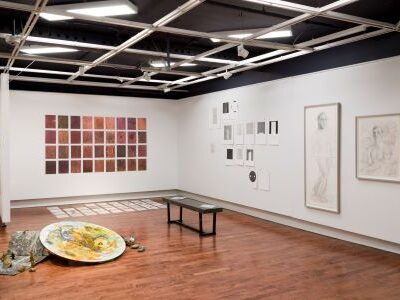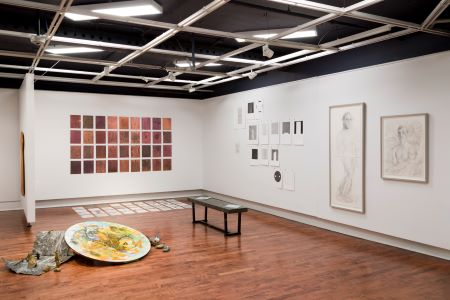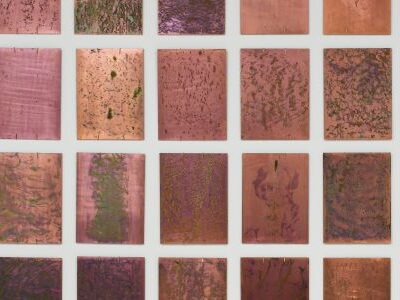Students interview artists Joe Di Leo and Sheena Hoszko
Re-Assembly: Emboldening the Temporal exhibits work from past students of Dawson’s Visual Arts program over the last 20 years, brought together by their teacher Giuseppe (Joe) Di Leo (Retired Faculty, Fine Arts). The exhibition, on view at the Warren G. Flowers Art Gallery at Dawson until Nov. 27, focuses on sharing ideas through different and diverse forms of drawing. Read what Joe and his former student Sheena Hoszko have to say about what this exhibition means to them.
Questions by Visual Arts students Olivia MacIntosh & Tristan Boisvert-Larouche.
T.B.-L.: (both artists) How does it feel to be reunited together at Dawson not as student/teacher but as co-contributor in an art exhibition?
Joe: It’s really, really gratifying. From my position as an instructor, I taught all these individuals years ago, and it was just great to be in the mix with them now after having taught them during their formative years. It’s gratifying to be back with them again. I used to be their instructor but now am on equal footing with them because the mentor-mentee relationship, within the context of this exhibition has been depoliticized. I am comfortable and I’m hoping that they feel comfortable as well to be exhibiting together with me. It feels like a family that you embrace at the very beginning and that you are equally responsible for. You really want to see them get ahead and grow in any way they want to, in any dimension, any direction. And to see that has happened over the years is encouraging and electrifying. To reassemble them in a group exhibition featuring 11 artists, myself included, is a circular and reciprocal journey making all the time and energy invested worthwhile. In other words, you reap what you sow, and this is what it’s all about. I’m learning from them too; I’ve become more self-actualized. I was very fortunate, very grateful to have had them as students, and curating this exhibition is my way of saying thank you.
Sheena: I feel immense gratitude. I began the Fine Arts program in 1999 and graduated in 2001. At the vernissage, I saw so many familiar faces—people I hadn’t seen in 20 years. It reminded me of the strong sense of community we shared at Dawson. I’m especially thankful to Joe for his dedication to teaching and for staying connected with everyone in various ways over the years. As someone who primarily works in sculpture, I feel truly honoured to be included in a drawing exhibition.
Joe: Well, thank you. Thank you for that, Sheena. This exhibition honours their practice, and honours their commitment to their work. The respect they have towards their practice stands to serve the community at large.
Sheena: I relate to my practice so differently at 42 than I did at 19 and continuing that conversation over the years with Joe and Dawson colleagues has been a true gift.
O.M.: (both artists) How do you feel about the Visual Arts program at Dawson? How has it impacted your art from a student and a teacher perspective? Why do you think that the program is so important for nurturing young artists?
Sheena: I appreciate how the Fine Arts program emphasized and introduced me to a shared studio culture. Having attended various institutions and schools, I’ve found that Dawson studio culture—sharing work, focusing on your own projects, discussing ideas, and simply spending time together—is truly foundational. It helped me understand what it means to be part of an artistic community.
Joe: How did teaching impact your art? I remember always saying that “I am an artist who teaches” – meaning that teaching is a creative act; it requires vigilance, surveying, passion, and compassion. I mean “creative” in terms of how you share your knowledge and information in a way that students feel respected and cared for, and consequently become inspired and responsible for their own learning. In this scenario the instructor is always critically thinking, researching, raising questions, reacting to and making judicious decisions about a student’s performance. This practice of teaching and nurturing is similar to a creative practice. It heightens my awareness as an artist and deepens my understanding of how to better communicate through my art making.
Sheena: I could share an anecdote to illustrate this of letting people find their way: I was in Joe’s life drawing class and remember showing him my portfolio. I felt somewhat indifferent about the drawings, and he said, “You’re not really into drawing, are you? Don’t worry, Sheena—you don’t need to draw to be an artist.” Hearing that during my formative years—an acknowledgment and acceptance of alternate paths—was profoundly meaningful and something I’ve carried with me ever since.
Joe: It’s about many things, establishing interconnections and channelling relationships and being aware of that. You don’t have to like everything you do but just that experience alone, that is knowing what you don’t like and how it affects you, you can build on that. Teaching is a creative endeavour and can be inspirational. Sometimes when I’m working on a drawing, I often think about how I would address my creative experiences with my students. That risk-taking, resisting and doubting, and failure of course, are all part of the equation. So, after a studio day where I feel I produced pure rubbish I can share this experience with them. Students need to know that regardless of what they produce, what appears to be unworthy is part of the process; we all have good and bad days in the studio, and that the ladder to success is made up of many rungs of failure.
O.M.: (Sheena Hoszco) I felt very drawn to your work, as the focus is on the prison system, can you speak to why this topic is so important to you?
One thing I try to remember and share with people when talking about the prison system, in Canada; is that prisons don’t keep us safe. If they did, we would not be surrounded by violence. The other thing I think is important to remember is that people are criminalized based on social and economic conditions. This is why Indigenous people, Black people, people of colour, poor people, queer people, and people struggling with mental illness are incarcerated at such high rates. An often-repeated statistic is that 50 per cent of people held in federal prisons for women are Indigenous. This is an extension of how the prison system was founded: as a way to remove people from their land and livelihoods. Based on these factors, I position myself as a prison abolitionist. I don’t think prisons can be reformed, and I am inspired by generations of people who believe this as well. Also, I have family who have been criminalized, and my art practice has been a way to understand and unpack the dynamics of incarceration.
T.B.-L.: (Sheena Hoszco) In order to create this work, you’ve had to travel quite a lot, would you consider this lengthy process a part of your work itself? In addition, how did it feel to go towards this kind of place that people try to ignore?
The project has taken a lot of time and travel, but it is rooted in my political beliefs about how we treat each other. It took a long time—about a year—to create the rubbings at various locations. I even learned to drive for this project, bought a van, and lived in it. Another role I take on is working with solidarity groups that go into prisons. I’ve been doing that for about 10 years. Prisons are intimidating, especially in terms of their architecture, but I also have friends and comrades inside who are incredibly important to me. It’s a double-edged sword: I understand the scariness, but I also know that the people inside are incredibly resilient within a very harsh context.
In Quebec and most parts of Canada, the further you go from big cities, the higher the security level of the institutions. The higher the security, the more the people inside are hidden. Sometimes, it was pretty tense to get near the buildings, and I couldn’t get too close. But it’s an administrative risk, I was not in real danger. This project has also helped me work through personal issues related to my family history and how I want to continue supporting prisoner justice. Four years ago, I went back to school. I’m currently a PhD candidate at Queen’s University in Cultural Studies, tracing art-making in prisons and its relation to social movements.
35+ Prisons in Québec is an ongoing project, and I’m still determining where it’s going or what the final form will be, if there is one, because I want it to disintegrate over time. What’s important about this project is that it feels more like an opening or starting point for more action.
T.B.-L.: (Joe Di Leo) Through both your works, there is a clear influence of the natural world, and I was wondering what is, to you, the relationship between art, the artist, and Nature?
It’s all interconnected, art is the product of my being part of Nature. Drawing takes time, drawing is time, time is duration; duration is intimacy; and intimacy is drawing. So, for me and nature, part of art-making is about how we’re all interconnected. I enjoy moving into Nature, I learn things in Nature, I live in Nature, I explore, I draw from Nature on occasion, and this kind of interconnectedness makes me who I am. It electrifies me, it is self-actualizing. These experiences allow me to better understand the post-human or the more-than-human sentiment beyond the Anthropocene, where humans see themselves above Nature. I believe we are all part of this one sentient world. Making art and enjoying experiences in Nature deals with re-imagining and reenacting the memory of momentary encounters with sentient beings. So, it is part of how I express my creativity: the idea of being part of something greater than myself. My drawings are a product of this idea and of the fascination with what it is that makes me whole.

Photo: Exhibition view: Joe Di Leo, Sheena Hoszko, Jinny Yu, Ian Stone. Photo by: document original.
Photo: Detail of Sheena Hoszko’s 35+ Prisons in Québec




